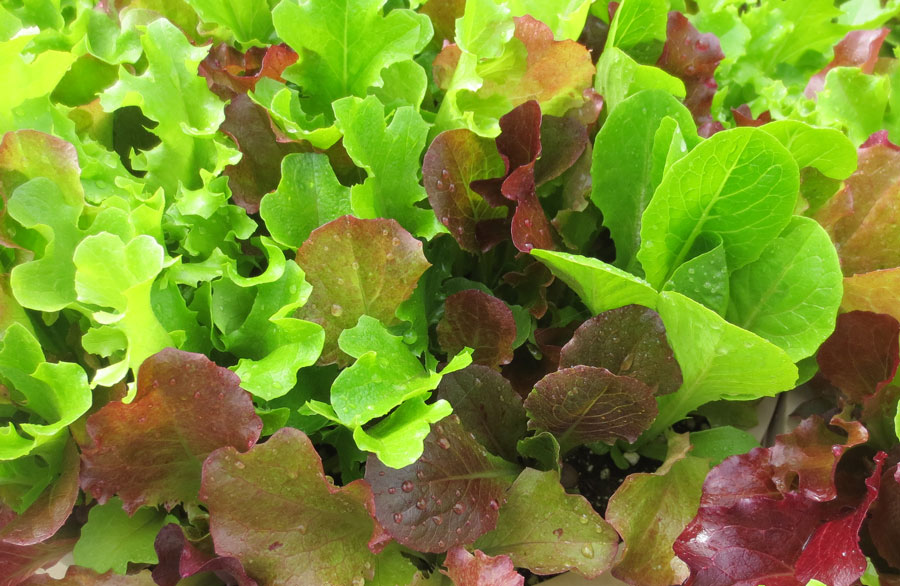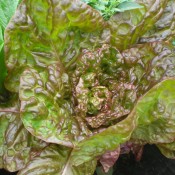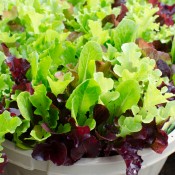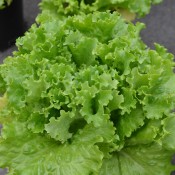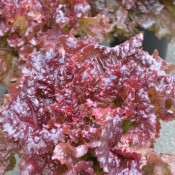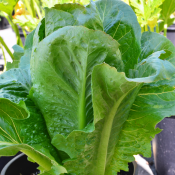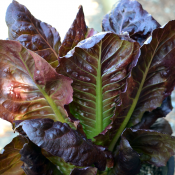Lactuca sativa.
The humble beginnings of lettuce began when it was first grown as a weed in the Mediterranean area. The early Romans, who treated lettuce as a luxury food, were intrigued by the milky juice or sap that exuded from the cut stem. In fact, the word lettuce derives from the Latin word lac, or “milk”. The Egyptians ate romaine-type lettuce that grew on the island of Kos off the Turkish coast. Lettuce consumption spread throughout Europe. In 1493 during his second journey to the Americas, Christopher Columbus sailed to the West Indies bringing lettuce seeds which were used to test the soil. By 1565, lettuce grew profusely in Haiti and by the 1600s cultivation began in the United States.
The four main market types of lettuce are:
- Butterhead, Bibb, or Boston lettuce is smaller, looser-headed lettuce with tender, delicately sweet flavoured leaves that bruise easily. These varieties are good for salad rolls or lettuce wraps.
- Iceberg or crisphead lettuce has a firm head that reaches about six inches in diameter. It has a great crisp texture and taste. Iceberg lettuce is perfect for Asian lettuce wrap, taco salad, or wedge salad.
- Looseleaf or leaf lettuce does not form a distinct head but grows in a circular patch or loose head. Its leaves are tender and may be smooth or crinkled, ruffled, or curled. They range from green and yellowish-green to reddish and bronze. To gardeners, they are also known as “cut and come again” because their individual leaves can be harvested and they will re-grow. Their flavourful leaves add taste and texture to salads and sandwiches.
- Romaine or Cos lettuce has long, stiff dark outer leaves with lighter green inner leaves. It has a sweet flavour and a crisp, coarse texture hence it is “the” lettuce for Caesar salads. Romaine-type lettuce cooks well because the leaves won’t dissolve so it can be grilled or braised.
Great salads start with freshly picked lettuce. Plant a mixture of different lettuce and supplement it with a range of spicy greens such as radicchio or arugula as well as vitamin-rich Swiss chard. Lettuce is easy to grow and can be grown in small spaces and in containers. They can be tucked between and under taller vegetables such as tomatoes, corn, and trellised pole beans.
Lettuce is a cool-weather crop and may bolt or develop a bitter taste in high temperatures and during long days. To counteract this, choose heat-tolerant and bolt-resistant varieties and plant in early spring or late summer. In the heat of summer, the plants should be protected or planted in spots with partial shade. All varieties of Tried & True® Edibles lettuce are chosen because they are slow to bolt. Because lettuce has shallow roots, care must be used when cultivating not to disturb the roots. Moist soil or consistent and frequent light watering makes the leaves grow rapidly, resulting in high-quality and tender leaves. Also, side-dress with mulch to keep the soil cool, moist and to control weeds. Careful not to overwater – this can lead to soft growth, disease, and burning of the leaf tips or margins.
Beets, brassicas (i.e. brussels sprouts, cabbage, kale, etc.), carrots, dill, onions, radish, spinach, squash, and strawberries all make great companions to lettuce. Also, chives and garlic are excellent companions because they deter aphids.
| Nutrition | Most lettuce are moderately good sources of iron, copper, vitamin C, vitamin A and other trace elements. The stems and ribs provide dietary fiber. The darker green the lettuce the more beta carotene. Lettuce is low in calories - one cup of most types of lettuce has about 10 calories and a whole head of iceberg lettuce has 70 calories. |
|---|---|
| Harvesting | Pick leaves from the outside edges of plants. The plants will continue producing new leaves from the center. Begin harvesting baby lettuce about two to three weeks after setting out transplants. Romaine lettuce forms its characteristic thick mid-rib before harvest; at full size, 20 – 30cm (8 – 12") it forms an upright leafy head. |
| Storing | Lettuce is best eaten just after harvesting. To store lettuce, refrigerate it unwashed in plastic bags for a few days. If you wash the lettuce, make sure the leaves are drip-dried and are stored in plastic bags in the refrigerator. Lettuce keeps best at 0°C (32°F) and high (96%) humidity. Avoid storing lettuce with bananas, apples, or pears - these release ethylene gas (natural ripening hormone) that will cause the lettuce to develop brown spots and break down quickly. |
Varieties Listing
This beautiful and striking lettuce is an old French Heirloom and has been commercially available since 1885. Vigorous growth forming 20 – 30cm (8 – 12 inches) wide rounded heads of green leaves deeply tinged with bright bronze-red. Also known as ‘Marvel of Four Seasons’ or ‘Merveille des Quatre Saison’ and as the name implies… Read more »
Add colour, flavour and texture to your salads with this gourmet and tasty assortment of salad leaves and old favourites. Good for baby leaf production and container gardening.
Bergam’s Green has tight uniform medium-large heads with dark green colour and attractive frilly leaves. This pretty non-heading type of lettuce has a nice sweet flavour. It is a high-yielding variety that is slow to bolt and tolerant to tip burn. Good for late spring, summer, and fall harvests.
This popular lettuce produces a substantial head of frilly reddish-bronze leaves with deep red margins. New Red Fire produces quality, medium-sized heads with strong upright leaves. Excellent tolerance to bolting and adaptability to warm and cool conditions.
Parris Island was introduced in 1952 and continues to be favourite amongst lettuce lovers. This romaine has upright heads of large thick medium-green slightly rumpled leaves with creamy white hearts. It is sweet, crisp and flavourful. Parris Island has superior uniformity and is slow to bolt.
Introduced before 1885, this well-known heirloom has smooth, flat, red-bronze-tinged leaves with green veins. In cold weather, the leaves turn an attractive deep red. This hardy and productive variety is resistant to heat and cold so it is suitable for spring, autumn, and winter crops.
Back to Organic Edibles.

